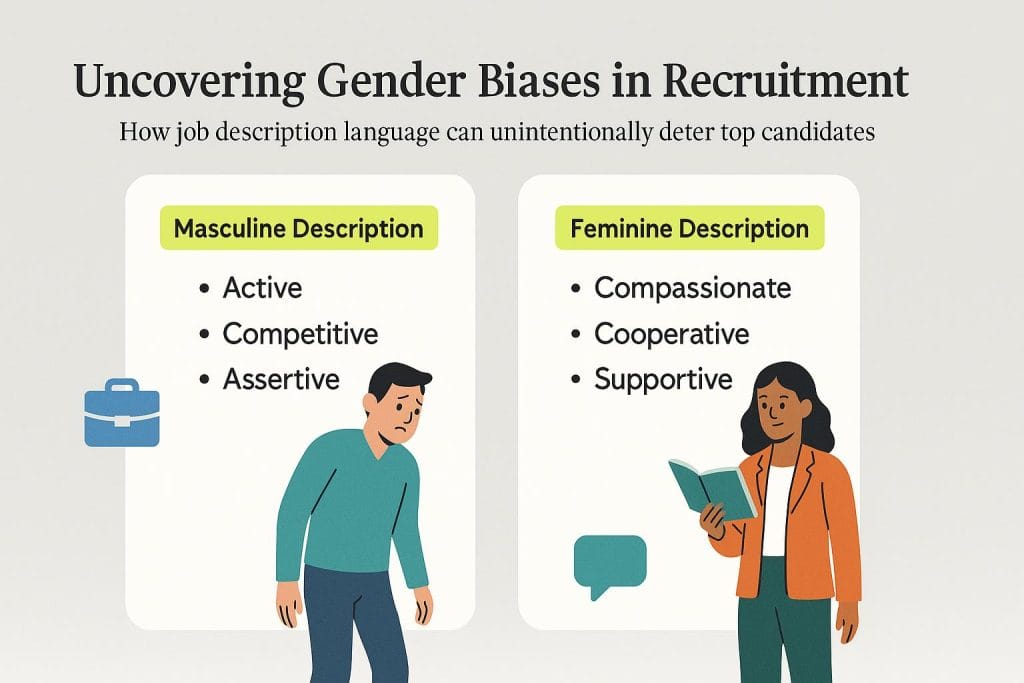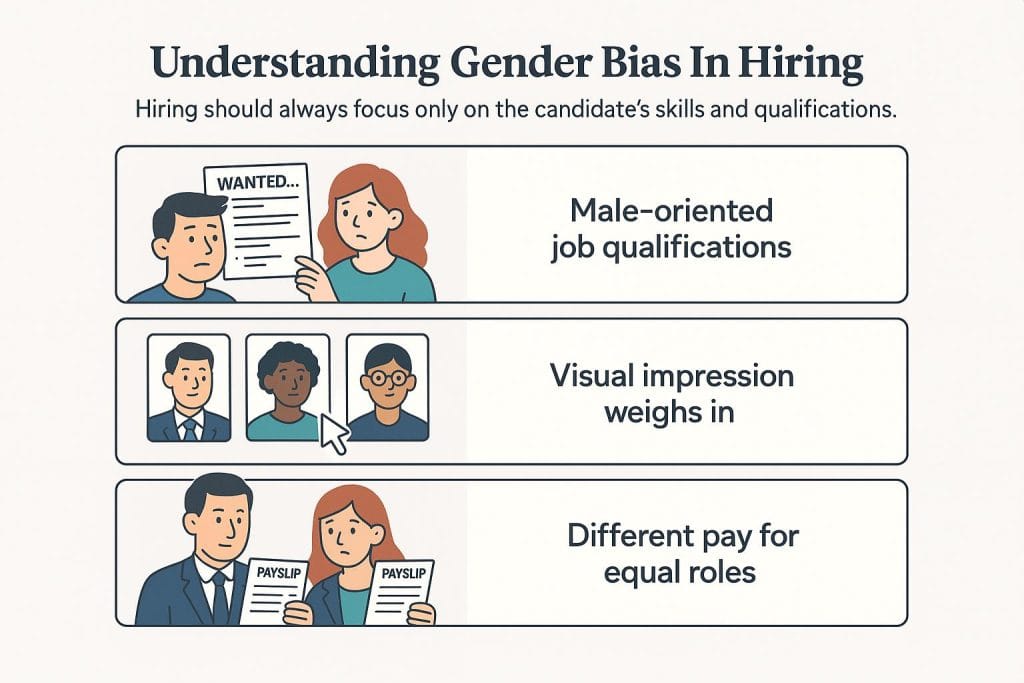Business.com aims to help business owners make informed decisions to support and grow their companies. We research and recommend products and services suitable for various business types, investing thousands of hours each year in this process.
As a business, we need to generate revenue to sustain our content. We have financial relationships with some companies we cover, earning commissions when readers purchase from our partners or share information about their needs. These relationships do not dictate our advice and recommendations. Our editorial team independently evaluates and recommends products and services based on their research and expertise. Learn more about our process and partners here.
The Hidden Ways Gender Bias Can Sabotage Recruitment
The job search is a game. Everyone approaches it with a different strategy — and gender can impact the search in ways you don't realize.

Table of Contents
Although you may think your recruiting process is fair, unconscious factors can quietly eliminate great candidates. Research from the United Nations Development Programme shows that nearly 90 percent of men and women hold at least one bias against women — a reminder of how pervasive inequality can be. Bias isn’t limited to gender, either. Transgender, nonbinary and gender-nonconforming workers also report frequent workplace discrimination. In fact, a Williams Institute study found that 82 percent of transgender employees have experienced discrimination or harassment on the job, from being passed over for promotions to facing verbal or physical mistreatment.
These numbers highlight how easily qualified people can be overlooked. By recognizing where bias shows up even in subtle ways, you can make your hiring process more inclusive and fair and ultimately build a stronger workforce.
Gender biases that can sabotage recruitment

Although gender biases are complex, recognizing and addressing them is the first step toward creating better workplaces for everyone. Here are five common gender biases that can sabotage your recruitment process.
Using masculine job descriptions
The wording in your job postings can make a bigger difference than you think. Research shows that ads filled with masculine-coded language attract fewer applications from women. Even subtle word choices can influence who decides to apply.
Some common masculine-coded words that often appear in job descriptions include:
- Active
- Aggressive
- Analytical
- Assertive
- Boast
- Competitive
- Courageous
- Determined
- Independent
- Self-sufficient
By contrast, women tend to respond more positively to postings that include more feminine-coded words, while men’s interest generally isn’t affected either way. Examples include:
- Committed
- Compassionate
- Considerate
- Cooperative
- Dedicated
- Interpersonal
- Loyal
- Responsible
- Supportive
- Understanding
When writing job posts, the goal isn’t to overcorrect but to strike a balance. Highlight the actual skills, experience and responsibilities for the role, and use language that makes all qualified candidates feel welcome to apply.
Taking application materials at face value
How candidates present their qualifications often differs by gender, which can create an uneven playing field during resume reviews. According to research cited in the European Journal of Social Psychology, men tend to apply for jobs when they meet about 60 percent of the listed qualifications, while women typically wait until they meet close to 100 percent. This self-selection bias means your applicant pool may already be tilted before you even start reviewing resumes.
Presentation also varies. Additional research shows that men are more likely to overstate abilities or exaggerate skills, while women often understate their achievements. As a result, a male candidate may appear more qualified on paper than a female candidate with equal — or even stronger — experience.
To avoid overlooking top talent, don’t rely solely on how applicants describe themselves. Check references and use objective, skills-based evaluations or assessments to identify who truly has the right capabilities for the job.
Making appearance-based decisions
Visual bias remains a persistent challenge in recruitment. According to a 2025 ResumeTemplates survey, more than half of hiring managers (53 percent) admit that a candidate’s physical traits influence their hiring decisions. Of this group, 40 percent said they would choose a conventionally attractive candidate over someone more qualified, 85 percent admitted to forming impressions of competence based on appearance, and 28 percent acknowledged judging female candidates more harshly on traits like attractiveness, weight and age.
These results underscore how easy it is for gender bias to creep into the hiring process and let appearance overshadow ability. First impressions are natural, but relying too much on looks means you could miss out on highly qualified candidates who would be a great fit for your team.
Tuning out feminine words
Communication style often shapes how candidates are perceived, sometimes unfairly. Applicants who highlight collaboration and teamwork may be seen as less leadership-oriented than those who frame their accomplishments in assertive, individual terms — even when they’ve achieved the exact same results.
Research on leadership diversity underscores this issue, noting that both traditionally “masculine” and “feminine” communication styles bring value to organizations. Yet hiring practices still tend to favor assertiveness and independence over cooperation and empathy, which can sideline highly capable candidates.
One way to counter this bias is to create a standard interview template that lists the hard and soft skills truly required for the role. Check off these skills as they come up in conversation, focusing on substance rather than style. This helps ensure that strong communicators of all kinds are fairly considered.
Brushing off salary negotiations
Even if you believe your pay structure is fair, salary negotiations often play a role in widening wage gaps. Research from the Pew Research Center shows that women are nearly as likely as men to negotiate pay (32 percent vs. 28 percent), but they don’t always see the same results. After negotiating, women are more likely than men (38 percent vs. 31 percent) to walk away with only the original offer.
One way to reduce this imbalance is to take negotiations out of the equation as much as possible by being upfront about pay. According to the Society for Human Resource Management (SHRM), 82 percent of U.S. workers say they’re more likely to apply for a job if the pay range is listed. And for employers, the benefits are clear: 66 percent of organizations that post ranges report seeing higher-quality applicants. Transparent salary ranges not only attract stronger candidates but also help level the playing field for everyone during the hiring process.
What is gender bias in hiring?

Gender bias in hiring is the intentional or unintentional act of discriminating against a job applicant based on their gender. The negative impact on cisgender women is commonly held up as the example, although it often affects transgender, nonbinary and gender-nonconforming applicants as well.
Eliminating gender bias requires conscious effort and systematic changes. This includes reviewing job descriptions for coded language, implementing structured interviews with standardized questions, using anonymized resume screening when possible, and establishing clear evaluation criteria before beginning the hiring process.
The long-term effects of gender bias in your organization
Gender bias should be addressed at every stage of the employee journey, starting with recruitment. Left unchecked, it can have lasting consequences for your business, including the following:
- Limited talent pool: When bias influences hiring decisions, you risk overlooking the best candidates. The cost of a bad hire can be steep, affecting team performance and growth, making it crucial to evaluate every applicant fairly.
- Inequality in the workplace: Bias in hiring often leads to fewer women — and fewer diverse candidates overall — in your workforce, especially in leadership roles. Building workplace diversity and inclusion requires actively eliminating these barriers.
- Lower profitability: McKinsey’s 2023 research shows companies in the top quartile for gender diversity on executive teams were 39 percent more likely to outperform on profitability compared to those in the bottom quartile.
- More of a pay gap: Steering women toward lower-paying jobs or paying them less than men for the same role perpetuates wage gaps. Employers should use fair, transparent rubrics to evaluate compensation and give all candidates the same opportunity to negotiate.
- Legal risk: Discrimination is not only unethical but also unlawful under Title VII of the Civil Rights Act of 1964. Consider that in fiscal year 2024, the EEOC recovered nearly $700 million for victims of discrimination through administrative enforcement and litigation — the highest amount in recent history. All employers should know the applicable employment and anti-discrimination laws and follow them to the letter to avoid HR compliance challenges and legal risks.
It’s crucial to train your staff on what gender bias looks like and how to avoid it. This can help you eliminate gender bias from your recruitment process.











